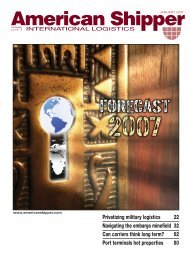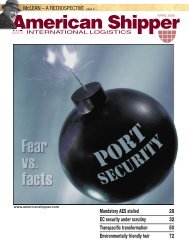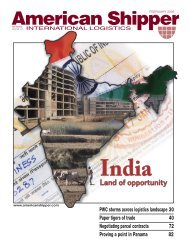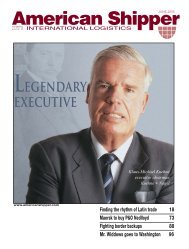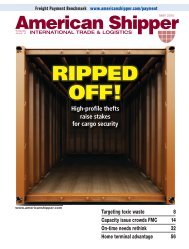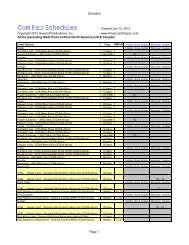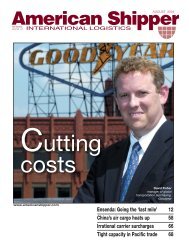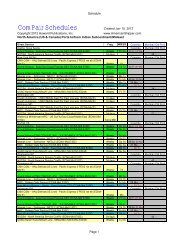Pirate Busters - American Shipper
Pirate Busters - American Shipper
Pirate Busters - American Shipper
You also want an ePaper? Increase the reach of your titles
YUMPU automatically turns print PDFs into web optimized ePapers that Google loves.
Trade Forecast 2009<br />
Armageddon or Schumpeter redux?<br />
Positioning your supply chain for recovery<br />
EXECUTIVE SUMMARY<br />
Though many have<br />
quarreled with (or<br />
misinterpreted) some<br />
of the conclusions reached in<br />
Joseph Schumpeter’s 1942<br />
book Capitalism, Socialism<br />
and Democracy, few would<br />
deny his title to the concept<br />
of evolutionary creative destruction<br />
and its impact upon<br />
corporate demise, resiliency<br />
and survival throughout the<br />
past century.<br />
One need only look at the<br />
companies listed as components<br />
of the Dow Jones<br />
Industrial Average over the<br />
New orders/shipments<br />
40%<br />
30%<br />
20%<br />
10%<br />
10%<br />
20%<br />
30%<br />
40%<br />
Sources: U.S. Department of Commerce, Global Insight, Material Handling Industry of America, 2009<br />
last 100 years to confirm the hypothesis. Schumpeter argued that<br />
entrepreneurs are the critical change agents whose challenges to<br />
status quo fuel and refuel economic growth.<br />
If ever there were a time for entrepreneurship, it would seem to<br />
be now. Our intent here is to take stock of where we are, assess<br />
the impact and issue a clarion call for proactive entrepreneurship<br />
to cut our losses, improve current performance and better position<br />
our organizations for accelerated recovery when the tide turns.<br />
Underestimates of the economic downturn’s impact on supply<br />
chain infrastructure have left a landscape of overcapacity, cancelled<br />
or deferred projects, and mothballed ships, trucks, warehouses and<br />
distribution centers across the country.<br />
• The Council of Supply Chain Management Professionals’ 2009<br />
State of Logistics Report puts the numbers in perspective. With a<br />
7.8 percent decline in industrial production in 2008, logistics costs<br />
as a percentage of gross domestic product dropped 3.5 percent to<br />
$1.3 trillion. CSCMP said the trend, which has devastated many<br />
service and equipment providers, will continue through 2009 and<br />
is unlikely to see a major correction before at least mid-2010.<br />
• U.S. freight transportation has stalled at its lowest level since<br />
1997, according to the U.S. Department of Transportation’s Bureau<br />
of Transportation Statistics. Total import volume at major U.S. ports<br />
is now expected to be 12.3 million TEUs for 2009, an 18.8 percent<br />
decline from 2008’s 15.2 million TEUs.<br />
• On the warehousing side of the equation, CB Richard Ellis<br />
said the national vacancy rate reached 10.2 percent at the end of<br />
June 2009, the highest since the second quarter of 2004.<br />
• Material handling suppliers have also been hit hard by the<br />
downturn. The Material Handling Industry of America reports<br />
that new orders for the first half of 2009 dropped 44.9 percent<br />
compared to the 2008 period, but forecasts the decline will slow<br />
in the second half, bringing the year-end total decline to about 35<br />
percent. Another 5 percent to 10 percent drop is expected in 2010<br />
with a return to growth in early 2011.<br />
0%<br />
Mar-00<br />
Sep-00<br />
Material handling equipment manufacturing<br />
forecast 2009-2010 vs. GDP<br />
Mar-01<br />
Sep-01<br />
Mar-02<br />
Sep-02<br />
Mar-03<br />
Sep-03<br />
Mar-04<br />
Sep-04<br />
Mar-05<br />
Sep-05<br />
Mar-06<br />
Sep-06<br />
Mar-07<br />
Sep-07<br />
Mar-08<br />
Sep-08<br />
Mar-09<br />
Sep-09<br />
Mar-10<br />
Sep-10<br />
Mar-11<br />
Sep-11<br />
We are not going to be rescued by another housing boom or the<br />
surge in consumer spending that took the Dow Jones Index above<br />
14,000 in October 2007. Further, “bailout” support is an unlikely<br />
option for any organization without a fairy godmother.<br />
What are the alternatives? “Waiting it out” is not an option;<br />
rather, it’s a prescription for potentially irrecoverable loss of market<br />
position — or worse.<br />
A corollary to Schumpeter’s creative destruction theorem, from<br />
Robert Simons of Harvard Business School, states that “the right<br />
of any corporation to exist is not perpetual, but has to be continuously<br />
earned.” Accordingly, whether it’s “thinking out of the box”<br />
or breaking it when it’s not broken, it’s time for us to do some<br />
entrepreneurial head clearing and take an innovative, bold but<br />
measured approach to assessment of how best to leverage the hidden<br />
opportunities within the current economic landscape. Given<br />
the latter, leadership should focus on gaining buy in and support<br />
from all employees by clearly articulating the challenges — and,<br />
collaboratively building and implementing action plans that address<br />
them showing specifically how individual performance impacts<br />
results — and then broadcasting actual results on a daily, if not<br />
hourly basis and explaining what has to be done to stay on target.<br />
Although the light at the end of your economic tunnel may only<br />
be a firefly today — regardless of where you are in the business<br />
cycle — there is no time like the present for fine-tuning strategies<br />
and action plans to be ready to charge out of the gate when the bell<br />
rings. In fact, if your industry lags those that appear to be bottoming<br />
out and on the way back up, there are still opportunities to batten<br />
the hatches, increase efficiencies and control costs to facilitate the<br />
recovery process. And, there’s good evidence that many organizations<br />
have already started.<br />
The balance of this article will focus upon how close examination<br />
of supply chain options can produce the short and longer-term benefits<br />
that sustain and differentiate world class corporate performers<br />
in good times and bad.<br />
Register and download the report at <strong>American</strong><strong>Shipper</strong>.com/TF<br />
6 AMERICAN SHIPPER: OCTOBER 2009<br />
Annual Rate of Change<br />
MH New Orders<br />
GDP Nominal +3Q<br />
MH Shipments<br />
Forecast<br />
8%<br />
6%<br />
4%<br />
2%<br />
0%<br />
-2%<br />
-4%<br />
GDP four quarter percent change



